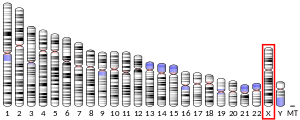Dock11
Dock11 (Dedicator of cytokinesis), also known as Zizimin2, is a large (~240 kDa) protein involved in intracellular signalling networks.[5][6] It is a member of the DOCK-D subfamily of the DOCK family of guanine nucleotide exchange factors (GEFs) which function as activators of small G proteins. Dock11 activates the small G protein Cdc42.
Discovery
Dock11 was identified as a protein which is highly expressed in Germinal center B lymphocytes.[7] Subsequent RT-PCR analysis revealed expression of this protein in the spleen, thymus, bone marrow and in peripheral blood lymphocytes. Dock11 is expressed at lower levels in NIH-3T3 fibroblasts, C2C12 myoblasts and Neuro-2A neuroblastoma cells. Dock11 mRNA has also been detected in the pars intermedia.[8]
Structure and function
Dock11 exhibits the same domain arrangement as other members of the DOCK-D/Zizimin subfamily and shares the highest level of sequence identity with Dock9.[7] It contains a DHR2 domain which mediates GEF activity and a DHR1 domain which may interact with membrane phospholipids. It also contains an N-terminal PH domain which may be involved in its recruitment to the plasma membrane. Dock11 binds and activates nucleotide-free Cdc42 via its DHR2 domain[7] and has also been reported to mediate positive feedback on active, GTP-bound Cdc42,[9] although this interaction required a small N-terminal region of Dock11 in addition to the DHR2 domain. Cdc42 in turn regulates signaling pathways that control diverse cellular functions including morphology, migration, endocytosis and cell cycle progression.[10] Gene expression studies have suggested that Dock11 may have a role in the development of pituitary and testicular tumours.[8][11]
References
- GRCh38: Ensembl release 89: ENSG00000147251 - Ensembl, May 2017
- GRCm38: Ensembl release 89: ENSMUSG00000031093 - Ensembl, May 2017
- "Human PubMed Reference:". National Center for Biotechnology Information, U.S. National Library of Medicine.
- "Mouse PubMed Reference:". National Center for Biotechnology Information, U.S. National Library of Medicine.
- "Entrez Gene: DOCK11 dedicator of cytokinesis 11".
- Côté JF, Vuori K (December 2002). "Identification of an evolutionarily conserved superfamily of DOCK180-related proteins with guanine nucleotide exchange activity". Journal of Cell Science. 115 (Pt 24): 4901–13. doi:10.1242/jcs.00219. PMID 12432077.
- Nishikimi A, Meller N, Uekawa N, Isobe K, Schwartz MA, Maruyama M (February 2005). "Zizimin2: a novel, DOCK180-related Cdc42 guanine nucleotide exchange factor expressed predominantly in lymphocytes". FEBS Letters. 579 (5): 1039–46. doi:10.1016/j.febslet.2005.01.006. PMID 15710388.
- Chien WM, Garrison K, Caufield E, Orthel J, Dill J, Fero ML (March 2007). "Differential gene expression of p27Kip1 and Rb knockout pituitary tumors associated with altered growth and angiogenesis". Cell Cycle. 6 (6): 750–7. doi:10.4161/cc.6.6.3986. PMC 2040307. PMID 17361101.
- Lin Q, Yang W, Baird D, Feng Q, Cerione RA (November 2006). "Identification of a DOCK180-related guanine nucleotide exchange factor that is capable of mediating a positive feedback activation of Cdc42". The Journal of Biological Chemistry. 281 (46): 35253–62. doi:10.1074/jbc.M606248200. PMID 16968698.
- Sinha S, Yang W (November 2008). "Cellular signaling for activation of Rho GTPase Cdc42". Cellular Signalling. 20 (11): 1927–34. doi:10.1016/j.cellsig.2008.05.002. PMID 18558478.
- Almstrup K, Leffers H, Lothe RA, Skakkebaek NE, Sonne SB, Nielsen JE, Rajpert-De Meyts E, Skotheim RI (August 2007). "Improved gene expression signature of testicular carcinoma in situ". International Journal of Andrology. 30 (4): 292–302, discussion 303. doi:10.1111/j.1365-2605.2007.00758.x. PMID 17488342.
Further reading
- Côté JF, Vuori K (August 2007). "GEF what? Dock180 and related proteins help Rac to polarize cells in new ways". Trends in Cell Biology. 17 (8): 383–93. doi:10.1016/j.tcb.2007.05.001. PMC 2887429. PMID 17765544.
- Côté JF, Vuori K (2006). "In vitro guanine nucleotide exchange activity of DHR-2/DOCKER/CZH2 domains". Methods in Enzymology. 406: 41–57. doi:10.1016/S0076-6879(06)06004-6. PMID 16472648.
- Meller N, Merlot S, Guda C (November 2005). "CZH proteins: a new family of Rho-GEFs". Journal of Cell Science. 118 (Pt 21): 4937–46. doi:10.1242/jcs.02671. PMID 16254241.
- Yelo E, Bernardo MV, Gimeno L, Alcaraz-García MJ, Majado MJ, Parrado A (July 2008). "Dock10, a novel CZH protein selectively induced by interleukin-4 in human B lymphocytes". Molecular Immunology. 45 (12): 3411–8. doi:10.1016/j.molimm.2008.04.003. PMID 18499258.



